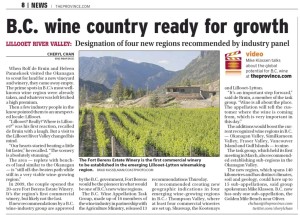Byline: Cheryl Chan, The Province
Designation of four new regions recommended by industry panel
When Rolf de Bruin and Heleen Pannekoek visited the Okanagan to scout for land for a new vineyard and winery, they came away empty. The prime spots in B.C.’s most well-known wine region were already taken, and whatever was left fetched a high premium.
Then a few industry people in the know pointed them to an unexpected locale: Lillooet.
 “Lillooet? Really? Where is Lillooet?” was his first reaction, recalled de Bruin with a laugh. But a visit to the Lillooet River Valley changed his mind.
“Lillooet? Really? Where is Lillooet?” was his first reaction, recalled de Bruin with a laugh. But a visit to the Lillooet River Valley changed his mind.
“Our hearts started beating a little bit faster,” he recalled. “The scenery is absolutely stunning.”
While the Okanagan is already dotted with vineyards, this area — also replete with benches similar to the Okanagan — is “still off-the-beaten path while still in a very viable wine-growing region.”
In 2009, the couple opened the 20-acre Fort Berens Estate Winery. It’s the region’s first commercial winery, but likely not the last.
If new recommendations by a B.C. wine industry group are approved by the provincial government, Fort Berens would be the pioneer in what would be one of B.C.’s new wine regions.
The B.C. Wine Appellation Task Group, made up of 16 members of the wine industry in partnership with the agriculture ministry, released 13 recommendations Thursday.
It recommended creating new geographic indications in four emerging wine-growing regions in B.C.: Thompson Valley, where at least four commercial wineries are set up, Shuswap, Kootenays and Lillooet-Lytton.
“It’s an important step forward,” said de Bruin, a member of the task group. “Wine is all about the place. The appellation will tell the customer where the wine is coming from, which is very important in this day.”
The additions would boost the current recognized wine regions in B.C. — Okanagan Valley, Similkameen Valley, Fraser Valley, Vancouver Island and Gulf Islands — to nine.
The task group, which held its first meeting in March, also recommended establishing sub-regions in the Okanagan Valley.
The region, which spans 140 kilometres and has distinct climates, soil, and geology, could have up to 15 sub-regions, said group spokesman Mike Klassen.
“A lot of the real mature winemaking in B.C. has been happening in the Okanagan Valley,” he said. “This is a good place for us to do that.”
B.C. now has only one sub-region, the Golden Mile Bench near Oliver.
The report suggested the names of the sub-regions should be of a nearby village or town, or have some historical significance to the area, to “humanize” the label for customers.
Other recommendations include discontinuing the use of taste panels to assess faults in wine made with 100 per cent B.C. grapes and harmonizing audits by three government and regulatory bodies into one.
The recommendations will be put toward an industry vote from December to February before going to government for approval.
